Scalabrino Laboratory
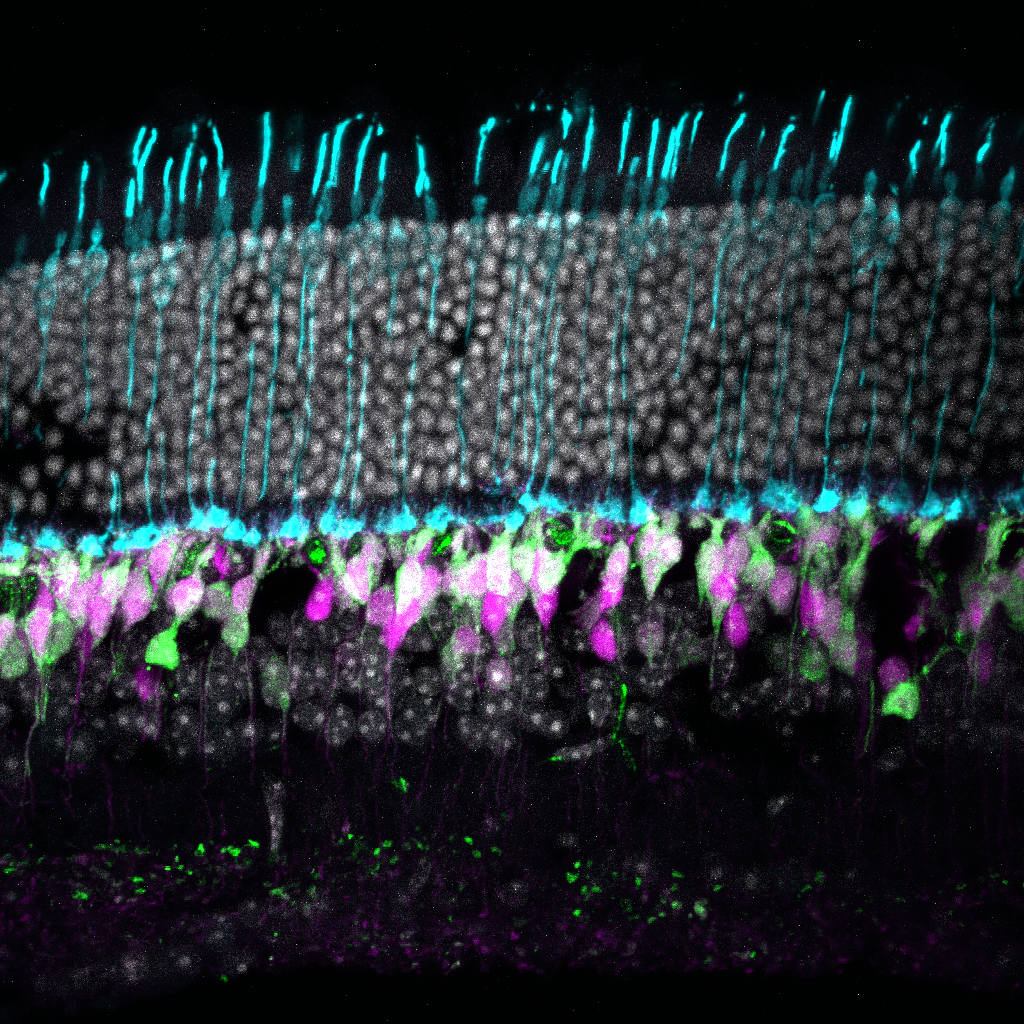
Research Areas
What causes continued photoreceptor degeneration following gene therapy?
In previous studies on a mouse model of retinitis pigmentosa, we found genetically rescued retinas continued to degenerate, as has been reported in additional animal models and patients of many neurodegenerations. A major goal of the Scalabrino lab will be to understand what factors contribute. By discovering the cause for continued cell loss, we can develop therapies that target the deficit, such as gene augmentation or cell replacement strategies.
How do mutation-specific and species-specific differences impact retinal pathogenesis?
Photoreceptor degenerations can be caused by >200 different gene mutations, making gene replacement strategies costly in both time and resources. This makes a gene-agnostic approach attractive, as it would reach more patients than gene replacement and reduce R&D-associated healthcare costs to make it accessible to a diverse population. There is currently a major bottleneck to developing a gene-agnostic therapy: much retinal disease research is performed on a few rodent models. While there are advantages to studying these lines, their relevance to human disease is limited. Thus, a second goal of the lab is to create and investigate diverse models of disease to look for common features a therapy may be able to solve irrespective of mutation, as well as discover mutation specific points of failure.
What developmental mechanisms can be leveraged to rescue retinal disease?
In both neural disease and development, cells undergo a variety of changes related to neuroplasticity, such as synaptogenesis and pruning, autophagy, and temporal gene expression. A third goal of the lab is to harness genes involved in neural development to improve gene and cell therapies for a wide variety of retinal diseases including retinitis pigmentosa, lebers congenital amaurosis, congenital stationary night blindness, and cone-rod dystrophy.
Image from a visually guided prey capture test
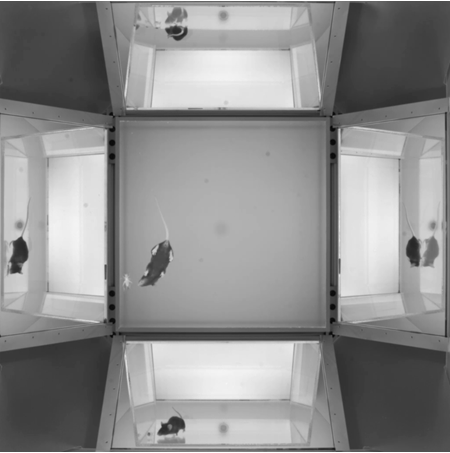
Retina expressing a calcium sensor in select retinal ganglion cells
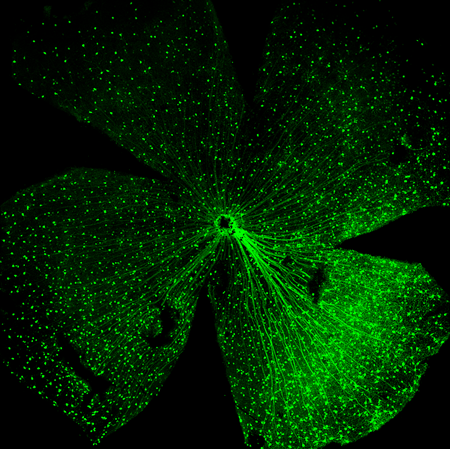
Confocal microscope image of retinal ganglion cells expressing an engineered receptor (red) with the ligand (green) used to chemically manipulate cell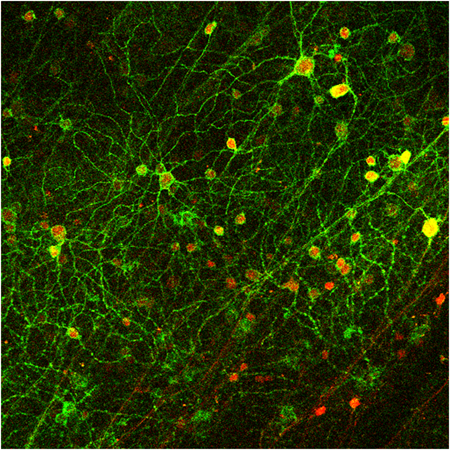
Multielectrode array used to record from ex vivo retinas
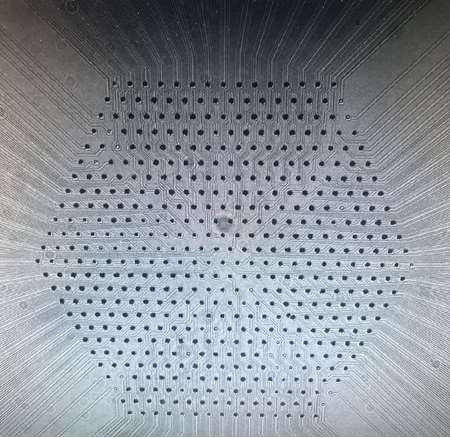
Current Members

Miranda L. Scalabrino, PhD
Assistant Professor of Ophthalmology & Visual Sciences; Assistant Professor of Cell Biology, Neurobiology and Anatomy

Molly Rose Rasper
Research Technologist II

Katharine Schwister
Year Entered MCW: 2023
Research Opportunities
Graduate student opportunities
If you are a PhD or Master's student at MCW or you are considering applying to MCW in a neuroscience, physiology, or cell biology related field, and you are interested in the visual system, treating blinding diseases, or learning how to apply novel computational approaches to complex neurobiological data, please contact us.Undergraduate opportunities
Are you an undergraduate in the Milwaukee area and want to get research experience in a laboratory doing biomedical research related to vision and neuroscience? We have a variety of projects you could contribute to. Please contact us for more information. Please include a brief description of what science, engineering and/or math classes you have taken, your planned major, and a few sentences about what you hope to pursue after college.We also have opportunities for summer students.
Research Technician opportunities
If you have a bachelor’s degree in any area of the natural sciences, math, engineering or computer science, and you want to bolster your research experience in an inclusive and dynamic environment, please contact us for information about research technician positions.Support the Scalabrino Lab
Donate Now
Recent Publications
-
(Scalabrino ML, Thapa M, Wang T, Sampath AP, Chen J, Field GD.) Nat Commun. 2023 Dec 12;14(1):8256 PMID: 38086857 PMCID: PMC10716155 SCOPUS ID: 2-s2.0-85179645989 12/13/2023
-
(Kellish PC, Marsic D, Crosson SM, Choudhury S, Scalabrino ML, Strang CE, Hill J, McCullough KT, Peterson JJ, Fajardo D, Gupte S, Makal V, Kondratov O, Kondratova L, Iyer S, Witherspoon CD, Gamlin PD, Zolotukhin S, Boye SL, Boye SE.) Mol Ther. 2023 Dec 06;31(12):3441-3456 PMID: 37814449 PMCID: PMC10727955 SCOPUS ID: 2-s2.0-85174458614 10/10/2023
-
Large-scale interrogation of retinal cell functions by 1-photon light-sheet microscopy.
(Roy S, Wang D, Rudzite AM, Perry B, Scalabrino ML, Thapa M, Gong Y, Sher A, Field GD.) Cell Rep Methods. 2023 Apr 24;3(4):100453 PMID: 37159670 PMCID: PMC10163030 05/09/2023
-
Cones and cone pathways remain functional in advanced retinal degeneration.
(Ellis EM, Paniagua AE, Scalabrino ML, Thapa M, Rathinavelu J, Jiao Y, Williams DS, Field GD, Fain GL, Sampath AP.) Curr Biol. 2023 Apr 24;33(8):1513-1522.e4 PMID: 36977418 PMCID: PMC10133175 SCOPUS ID: 2-s2.0-85152914523 03/29/2023
-
Neuroscience: Visual restoration with optogenetics.
(Scalabrino ML, Field GD.) Curr Biol. 2023 Feb 06;33(3):R110-R112 PMID: 36750022 SCOPUS ID: 2-s2.0-85147627541 02/08/2023
-
Robust cone-mediated signaling persists late into rod photoreceptor degeneration.
(Scalabrino ML, Thapa M, Chew LA, Zhang E, Xu J, Sampath AP, Chen J, Field GD.) Elife. 2022 Aug 30;11 PMID: 36040015 PMCID: PMC9560159 SCOPUS ID: 2-s2.0-85139880693 08/31/2022
-
Tissue-Dependent Expression and Translation of Circular RNAs with Recombinant AAV Vectors In Vivo.
(Meganck RM, Borchardt EK, Castellanos Rivera RM, Scalabrino ML, Wilusz JE, Marzluff WF, Asokan A.) Mol Ther Nucleic Acids. 2018 Dec 07;13:89-98 PMID: 30245471 PMCID: PMC6154398 09/25/2018
-
(Boye SL, Bennett A, Scalabrino ML, McCullough KT, Van Vliet K, Choudhury S, Ruan Q, Peterson J, Agbandje-McKenna M, Boye SE.) J Virol. 2016 Apr;90(8):4215-4231 PMID: 26865709 PMCID: PMC4810560 SCOPUS ID: 2-s2.0-84963826914 02/13/2016
-
Novel Methodology for Creating Macaque Retinas with Sortable Photoreceptors and Ganglion Cells.
(Choudhury S, Strang CE, Alexander JJ, Scalabrino ML, Lynch Hill J, Kasuga DT, Witherspoon CD, Boye SL, Gamlin PD, Boye SE.) Front Neurosci. 2016;10:551 PMID: 27990105 PMCID: PMC5131003 12/19/2016
-
(Scalabrino ML, Boye SL, Fransen KM, Noel JM, Dyka FM, Min SH, Ruan Q, De Leeuw CN, Simpson EM, Gregg RG, McCall MA, Peachey NS, Boye SE.) Hum Mol Genet. 2015 Nov 01;24(21):6229-39 PMID: 26310623 PMCID: PMC4612567 SCOPUS ID: 2-s2.0-84949238699 08/28/2015
Contact
Scalabrino Lab
(414) 955-7803



